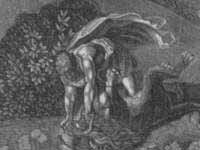
Declaration of the Anti-Slavery Convention, 1833 |
The abolitionist movement took shape in 1833, when William Lloyd
Garrison, Arthur and Lewis Tappan, and others formed the American
Anti-Slavery Society in Philadelphia. The group issued this
manifesto announcing the reasons for formation of the society and
enumerating its goals. The broadside includes the names of
delegates from ten states, to the Anti-Slavery Convention.
"Declaration of the Anti-Slavery Convention Assembled in
Philadelphia, December 4, 1833"
R[ueben] S. Gilbert, Illustrator
Philadelphia: Merrihew & Gunn, 1833
Broadside
Rare Book and Special Collections Division (47)
|
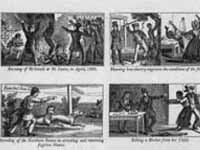
Illustrations of the Anti-Slavery Almanac |
Each year the American Anti-Slavery Society distributed an
almanac containing poems, drawings, essays, and other
abolitionist material. This broadside groups together
illustrations of the horrors of slavery that were used in the
1840 edition.
"Illustrations of the Anti-Slavery Almanac for 1840"
New York: American Anti-Slavery Society, 1840
Broadside
Rare Book and Special Collections Division (48)
|
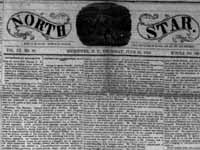
Frederick Douglass's North Star |
From 1847 to 1863, escaped slave and abolitionist Frederick
Douglass (1817-1895) published the North Star with the aid of
money and a press provided by British philanthropists. The paper
was published in Rochester, New York. Douglass's goals were to
"abolish slavery in all its forms and aspects, advocate UNIVERSAL
EMANCIPATION, exalt the standard of public morality, and promote
the moral and intellectual improvement of the COLORED PEOPLE, and
hasten the day of FREEDOM to the Three Millions of our enslaved
fellow countrymen." The paper also advanced women's rights, a
cause that Douglass had championed since his participation in the
first women's rights convention of 1848. Douglass also published
another abolitionist paper, the Frederick Douglass Paper.
North Star, June 20, 1850, p. 1
Newspaper
Serial and Government Publications Division (49)
|
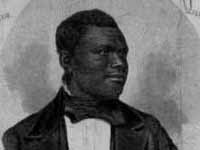
Fugitive Slave Anthony Burns |
This broadside shows Anthony Burns, whose arrest and trial under
the Fugitive Slave Act of 1850 touched off riots and protests by
abolitionists and citizens of Boston in the spring of 1854. A
bust portrait of the twenty-four-year-old Burns is surrounded by
scenes from his life. These include the sale of the young Burns
at auction, his escape from Richmond, Virginia, his arrest in
Boston, his trial, and his departure from Boston escorted by
armed marshals, to be returned to slavery in Virginia. The Burns
case became a rallying point for opponents of slavery, who
produced this broadside to remember his unjust treatment.
"Anthony Burns"
Boston: R.M. Edwards, 1855
Broadside
Prints and Photographs Division (50)
|
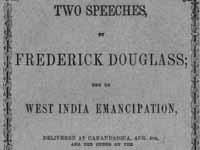
Publications of Frederick Douglass |
Frederick Douglass (1817-1895) was born a slave, but escaped
North to freedom in 1838. He became a celebrated abolitionist
speaker, and his speeches were widely circulated in print.
Douglass used his lecture fees to aid fugitive slaves and headed
the Rochester station of the underground railroad. One of the
speeches in this pamphlet was delivered at a celebration of the
anniversary of the abolition of slavery in the West Indies on
August 1, 1834. Before emancipation in the United States, West
Indian emancipation day was widely celebrated by opponents of
slavery. In the second speech, Douglass denounces the
controversial Dred Scott decision of March 6, 1857, in which the
Supreme Court, under Chief Justice Roger B. Taney, denied Scott's
claim that he was free because he had been taken into free
territory and declared that no black could be a citizen under the
Constitution.
Two Speeches by Frederick Douglass,
Rochester, New York: C.P. Dewey, 1857
Manuscript Division (51)
|
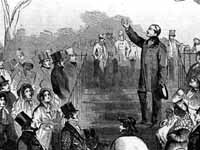
Wendell Phillips Speaks Against the Fugitive Slave Law |
The illustration is from a popular nineteenth-century
publication. It shows reformer Wendell Phillips (1811-1884)
addressing an April 11,1851 meeting to protest the case of Thomas
Sims, a fugitive slave being tried in Boston. A fiery and
persuasive orator, Phillips was a member of the Boston Committee
of Vigilance that tried to prevent Sims from being returned to
slavery. The attempts failed and on April 13, United States
marshals marched Sims to a ship that returned him to Savannah,
where he was publicly whipped.
Anti-Slavery Meeting on the [Boston] Common
From Gleason's Pictorial, May 3, 1851
Photomural from woodcut
Prints and Photographs Division (52)
|
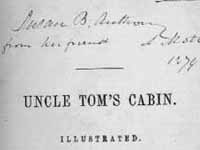
Copy of Uncle Tom's Cabin Owned by Noted Abolitionists |
In 1903, women's rights activist Susan B. Anthony (1820-1906)
gave her personal book collection to the Library of Congress.
Before sending the books, Miss Anthony inscribed many of the
volumes. Her notations explain that this copy of Uncle Tom's
Cabin was originally given to well-known anti-slavery and women's
rights advocate Lydia Mott by her friend William
Topp, a tailor and black abolitionist from Albany, New York. In
1874, Miss Mott gave the book to Miss Anthony. Published in
1852, Uncle Tom's Cabin sold 300,000 copies in its first year and
intensified significantly the polarization of abolitionist and
anti-abolitionist sentiment that contributed to the Civil War.
Uncle Tom's Cabin, Half title page
Harriet Beecher Stowe
Boston: John P. Jewett & Company, 1853
Susan B. Anthony Collection
Rare Book and Special Collections Division (53)
|
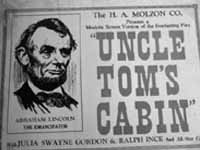
Film versions of Uncle Tom's Cabin |
Uncle Tom's Cabin was often produced as a play and later as a
film, and many people who did not read the book saw it
dramatized. Although white actors usually played the parts in
blackface, some productions starred African-American actors and
singers. At least seven silent versions had been made by 1927,
and a black actor, Sam Lucas, first played the title role on film
in 1914. This title card, used in theater lobbies to advertise
the film, is from a rare issue of a thirty-minute silent film
originally released by Vitagraph Studio in 1910. Directed by J.
Stuart Blackton, a noted director of the period, this version
featured Maurice Costello, Clara Kimball Young, and Norma
Talmadge, all of whom became major stars.
Title card for "Uncle Tom's Cabin," ca. 1910
H.A Molzon Company
Motion Picture, Broadcast, and Recorded Sound Division (53.1)
|

Anti-Slavery Broadside |
The large woodcut image of a slave in chains was originally
adopted as the seal of the Society for the Abolition of Slavery
in England in the 1780s and appeared on medallions made by Josiah
Wedgwood as early as 1787. A popular image, it often appeared in
anti-slavery publications. On this broadside of 1837, the image
is coupled with "Our Countrymen in Chains," a famous poem by
Quaker author John Greenleaf Whittier (1807-1892). Among his
many anti-slavery publications was an entire volume, Poems
Written During the Progress of the Abolition Cause in the United
States (1837). In 1833 Whittier acted as secretary of the Anti-
Slavery Convention at Philadelphia and was one of the committee
that drafted its declaration of principles.
"Our Countrymen in Chains"
John Greenleaf Whittier, Author
New York: Anti-Slavery Office, 1837
Broadside
Rare Book and Special Collections Division (54)
|
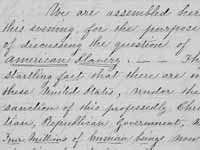
Susan B. Anthony Attacks Slavery |
Susan B. Anthony, a powerful speaker and writer, campaigned for
temperance and abolition as well as women's rights. Like many
suffragettes, she saw parallels between the lack of rights and
opportunities for women and the bondage of slavery. When the
Fourteenth Amendment to the Constitution granted the vote to
black males, Anthony fought unsuccessfully to have women
included. In this speech from 1859, Miss Anthony urged her
audience to "make the slave's case our own." She further
entreated, "Let us feel that it is ourselves and our kith and our
kin who are despoiled of our inalienable right to life, liberty,
and the pursuit of happiness, that it is our own backs that are
bared to the slave-driver's lash... that it is our own children,
that are ruthlessly torn from our yearning mother hearts."
"Make the Slave's Case Our Own," 1859
Susan B. Anthony, Author
Holograph
Manuscript Division (55) |









![[Previous]](prev.gif)
![[Next]](next.gif)
 Library of Congress
Library of Congress